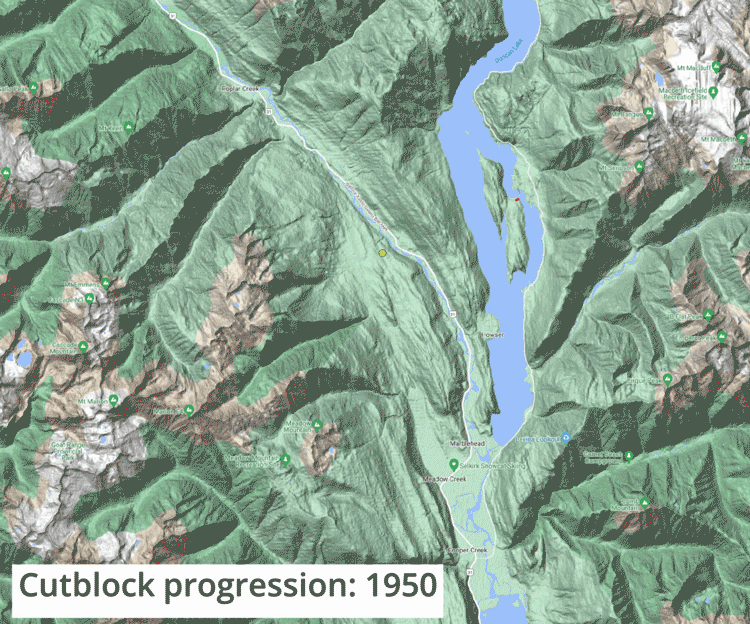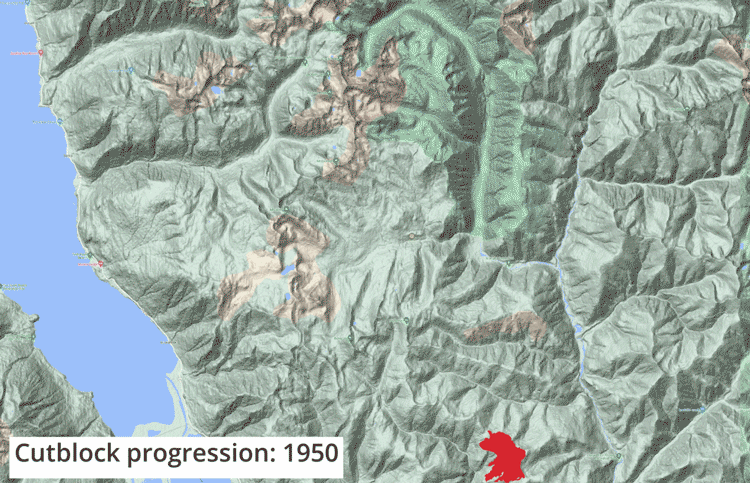If you fly over British Columbia, the most acute problem affecting our forests becomes alarmingly clear; it’s not just Fairy Creek, old growth logging or clearcutting, it’s the astonishing rate of logging that is happening due to the provincially set Annual Allowable Cut. This rate of cut threatens the viability of our province’s biodiversity, our communities’ drinking water, and in many cases Indigenous cultural values.
The Allowable Annual Cut (AAC) — how much will be logged every year in a specific area — is determined by BC’s chief forester roughly every 10 years through a Timber Supply Review process. Right now, the Kootenay Lake Timber Supply Area, including Nelson and Creston, is under review — and you have a chance to comment, until July 4th.
For nearly 30 years we have known that Annual Allowable Cuts are set way too high. In the 1980s, the Forests Ministry acknowledged the falldown effect, meaning we’re logging much faster than our forests are growing back. Wade Davis summarised it best:
The ‘falldown effect,’ the decline in timber production as the old growth is depleted, is promoted as if it were a natural phenomenon when it is, in fact, a stunning admission that the forests have been drastically over cut every year since modern forestry was implemented in the 1940s.
While it’s been over 40 years since the falldown effect was first acknowledged by the BC government, they still haven’t reduced the Annual Allowable Cuts to sustainable levels. In the Kootenay Lake Timber Supply Area we’ve watched as excessive logging have harmed community watersheds in places like Balfour and Wynndel. We’ve watched as caribou have been extirpated from the landscape both in the Southern Purcells and the Southern Selkirks because of the logging of old growth forests.

The Timber Supply Review process uses an ‘oldest first’ logging strategy, where we cut the oldest and most productive forests first. This is exactly the opposite of our government’s commitment to protecting remaining old growth forests.
New computer modelling techniques have largely overtaken boots-on-the-ground fieldwork that measures what’s actually happening in BC’s forests. I have spoken to forestry planners and others working in the industry who struggle to find the trees on the ground that the province says are there in the Annual Allowable Cut. Simply put, there’s just not much left of our forests. Cut rates need to be radically reduced if we want to have healthy watersheds, biodiversity, and old growth forests —and a forest industry in the future.
The old adage is that when you find yourself in a hole, stop digging.

Our province’s chief forester must stop digging and set a realistic cut level that reflects the on-the-ground reality of our forests, the priorities of local communities and Indigenous Nations, and the health of our ecosystems.
The comment period has ended. You can read Wildsight’s comments here.
The Ministry of Forests was accepting comments on the Kootenay Lake Timber Supply Area Review until July 4th. Click here to write your comments to:
- Ian Wiles, Stewardship Officer, Selkirk Resource District (Ian.Wiles@gov.bc.ca)
- Shane Berg, Chief Forester (Shane.Berg@gov.bc.ca)
- Honourable Bruce Ralston, Minister of Forests (FOR.Minister@gov.bc.ca)
- Forest Analysis and Inventory Branch, Victoria (Forests.ForestAnalysisBranchOffice@gov.bc.ca)
Add your location after your name, so they know that you’re local to the area.
Key issues to consider to write your comments
The most important message is that cut levels must be radically reduced to reflect the on-the-ground reality of our forests, the priorities of local communities and Indigenous Nations, and the health of our ecosystems.
Old Growth
- The province must stop using an oldest-first harvest strategy in the Timber Supply Review Process. We should be protecting our old growth, not targeting these stands for logging.
In many parts of the Kootenay Lake TSA, less than 10% of the old growth forests are still standing. It’s time to stop logging old growth and to calculate the Annual Allowable Cut with the assumption that no more old growth will be cut. - The Annual Allowable Cut is based on the Timber Harvesting Land Base (the area of forest that is theoretically available for logging over time). Even though BC has deferred logging on 62,055 hectares of old growth forest in the Kootenay Lake Timber Supply Area, they still are including many of these areas in the Timber Harvesting Land Base, meaning other areas suffer even more logging because the calculations are based on forests that aren’t really available for logging. The chief forester has to adjust the AAC to account for the areas set aside for old growth.
- Seventy-eight percent of designated Old Growth Management Areas (another designation meant to protect old growth) over two hectares in size in the Kootenay Lake TSR are actually in sub-alpine areas that cannot be logged anyways. Old Growth Management Areas should be designated where old growth can actually be protected from logging. Pretending to protect something that was never threatened by logging just inflates the numbers.
Protect Our Water
- The current and projected AAC relies on harvesting community watersheds. Thirty percent of the Timber Harvesting Land Base is in community watersheds. We need a precautionary approach that excludes community watersheds from the Timber Harvesting Land Base. We have to protect our drinking water. Industrial logging in watersheds sends sediment downstream into our drinking water, reducing water quality. Logging large swaths of mature forest in watersheds also makes floods in our communities more likely. Recent literature suggests that after 30% of a watershed is logged, what used to be a once-in-a-century flood comes around every 15 years.
Climate Change Realism
- We know that climate change will result in more fires and flooding, increased regeneration delays, more extreme weather, and more beetle outbreaks. That means less wood available. The Ministry says that we can’t forecast the exact quantitative effects of climate change, so they pretend those effects don’t exist. The Ministry must reduce cut levels to a precautionary level to account for climate change.
Look Forwards, Not Backwards In The TSR
- The TSR process has to look forward and integrate reasonable assumptions about our future and on-the-ground realities into models used to calculate the Annual Allowable Cut. That means not only that old growth deferrals and community watersheds need to be taken out of the Timber Harvesting Land Base, but also that government commitments to shifting away from clearcut logging, improving forestry practices on the ground and ecosystem needs all must be incorporated into the model.
Thanks for speaking up!








